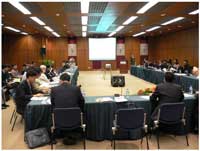| Detail |
1. Introduction
From September 4 through September 8, 2006, Workshop on Integrating Activities of the Hydrology, Meteorology and DPP (Disaster Prevention and Preparedness) components of the Typhoon Committee into the Related International Frameworks for Disaster Risk Management for Better Impacts and Visibility was held in Macau.
2. Typhoon Committee Workshop
The Typhoon Committee was co-founded by World Meteorological Organization (WMO) and United Nation Economic and Social Commission for Asia and the Pacific (UN-ESCAP) in 1968 with an aim to minimize the damage caused by typhoons in the member countries and regions of ESCAP.
The Typhoon Committee consists of three components, the Meteorology Component, Hydrology Component, and Disaster Prevention and Preparedness Component, and workshops by each component and a general assembly meeting are held every year. In recent years, the general assembly meeting was held in Thailand, Malaysia, China, and Vietnam, and workshops by the Hydrology Component were held in the Philippines, China, South Korea, and Malaysia, etc.
The workshop this year was co-hosted by the three components for the first time. Approx. 70 people took part in the workshop from various countries and organizations, including Cambodia, China, North Korea, Hong Kong (China), Japan, Laos, Macau (China), Malaysia, the Philippines, South Korea, Thailand, U.S., Vietnam, WMO, ESCAP, and TCS.
The participants from Japan are listed below:
- Eiji AOKI, Director for Planning (Mitigation), Cabinet Office (Disaster Management), Government of Japan
- Hideaki MIZUNO, Senior Researcher, National Institute of Land and Infrastructure Management, Ministry of Land, Infrastructure and Transport
- Nobutaka MANNOJI, Head, National Typhoon Center, Forecast Division, Forecast Department, Japan Meteorological Agency
- Katsuhito MIYAKE, Director, Research Department, Water Resources Environment
- Technology Center (WEC)
- Kazuhisa ITO, Director, 2nd Research Department, Infrastructure Development Institute, Japan
- Tadao KUBO, Senior Assistant Director, Infrastructure Development Institute, Japan
- Hideki ARAKI, Senior Researcher, Infrastructure Development Institute, Japan
- Akira SASAKI, Manager, CTI Engineering Co., Ltd.
- Kenji SUZUKI, Project Leader, Japan Water Forum (NPO)
- Nobuaki KATO, Sabo Technical Center
Japanese participants from other countries are listed below:
- Yuichi Ono, Officer in Charge, Platform for the Promotion of Early Warning, UN ISDR
- Koji Kuroiwa, Chief, Tropical Cyclone Programme, WMO
During the workshop, information was exchanged between the participating countries, the progress of on-going project was reported, and the future course of action for the Typhoon Committee was discussed.
3. Sabo-related project
In the Sabo field, Japan serves as a presiding country and carries on with a project called “Establi
shment of flash flood warning system including debris flow and landslide” with an aim to establish the method of setting up the rainfall warning criteria for sediment-related disasters in each country.
The plan of this project is to designate pilot test areas in each country, set up the warning and evacuation criteria for rainfall, and test the criteria in the pilot test areas by the end of 2005. In and after 2006, the target areas will be expanded in addition to the pilot test areas. The guideline for establishment of warning and evacuation criteria, which was created by Japan, contains the method of setting up the CL.
Mr. Mizuno, who is a project leader, made a presentation in which he explained the project overview, recent efforts at the rainfall warning criteria in Japan, the progress in each country, and establishment of technical helpdesk.
It was proposed that technical helpdesk should be provided on the web, which will enable the member countries to download guidelines for establishing the rainfall criteria, receive responses to their inquiries through e-mail from Japan, and share Q&A information.
Also, the progress of this project was reported from China, Hong Kong, Malaysia, South Korea, Thailand, and U.S. There is a significant difference in the progress of the project between countries. While the project is in operation in pilot test areas in some countries such as China and Malaysia, it has not started yet in some countries which did not make a presentation in the workshop. How these countries should carry out the project is an issue to be solved.
4. Conclusion
In this workshop, discussions about many other projects were also made. The Sabo project received favorable comments from many participants for the reason that it did not need much cost compared with other projects.
In the member countries of the Typhoon Committee, sediment-related disasters still cause many deaths every year. I realized again the necessity to actively advance technology transfer including other Sabo technologies to overseas countries.

Conference

Office of the Typhoon Committee under construction
|

